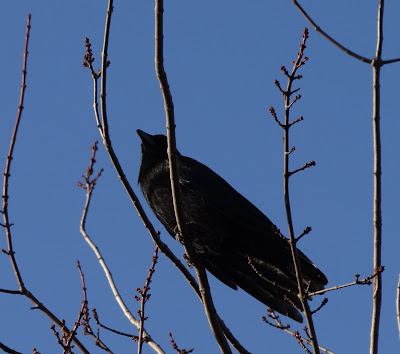
If you want to watch wildlife, you probably won’t drive to a giant supermarket car park on the urban fringes of London. As you park there to load up with your weekly shop, it's easy to overlook the avian spectacle flapping around your feet. Not just a wildlife spectacle but a miracle of adaptation.
Sainsbury’s
megastore on the London side of Epsom is home to scores of crows. Now you’re
disappointed: crows! Those horrible black scavengers, common as muck and mythologised
as harbingers of doom– even associated with the devil in medieval times. Collectively,
they’re known as a “murder” of crows. In Van Gogh’s last and darkest
painting, the crows gathering among storm clouds on a black horizon are omens of doom.
But if you
share my interest in wildlife behaviour, pause by your car for a few moments to
watch them next time you go shopping. I’ve long been fascinated by the way these crows, one of our most intelligent and adaptable birds, have
created a perfect habitat for themselves in a massive car park – a human cityscape ironically symbolic of everything we are doing to harm the natural environment.High rise lamps provide the perfect lookout to survey the site for battles and feeding opportunities. Car roofs and trolleys put the crows nearer the ground to scout for scraps of food, while keeping them safe from traffic, and the pavement outside the store front is a tablecloth covered with sticky wrappers, sandwich crusts and crumbs dropped by snacking shoppers. Think what they save Sainsbury's in litter removal...
The supermarket has thoughtfully planted some trees among the parking aisles, shading
windscreens from the sun in summer and helping to re-oxygenate a large outdoor fume
cupboard. But they’re good for perches too – just high enough to escape from a
tetchy shopper – and there are some of those about.
 Behind the car park is a long screen of mature trees whose branches
hold a sizeable roost. The colony is so large in winter that I thought
they must be rooks, but no, they are indeed carrion crows, Corvus corone.
Behind the car park is a long screen of mature trees whose branches
hold a sizeable roost. The colony is so large in winter that I thought
they must be rooks, but no, they are indeed carrion crows, Corvus corone.
I spent a
couple of hours watching and photographing the Sainsbury's colony ("murder" is such a loaded term) in their most urban of
habitats. And, as I did, I felt a growing sense of thankfulness that at least some wild creatures are able to adapt and thrive in our tarmac towns. None of these
species is universally popular: crows, foxes, grey squirrels, rats and pigeons
are often lumped together under the term “vermin” – a word I refuse to admit into my personal dictionary (unless we accept homo sapiens as “environmental pest-in-chief”. And look at the photo below: what a bird with attitude! Behind the car park is a long screen of mature trees whose branches
hold a sizeable roost. The colony is so large in winter that I thought
they must be rooks, but no, they are indeed carrion crows, Corvus corone.
Behind the car park is a long screen of mature trees whose branches
hold a sizeable roost. The colony is so large in winter that I thought
they must be rooks, but no, they are indeed carrion crows, Corvus corone.Imagine if there were no wild creatures capable of exploiting urban habitats…Our towns and cities would feel so empty.
 I’ve
spent fruitless hours googling the phrase “Stone the crows”, an expression of surprise or
annoyance, and I can’t find an adequate explanation of how it acquired this
meaning and usage. When farming was a widespread occupation, children were
employed to throw stones at crows stealing crops. I can easily understand that the arrival of
crows in fields ripe for harvest would have been annoying, but surely not a
great surprise!
I’ve
spent fruitless hours googling the phrase “Stone the crows”, an expression of surprise or
annoyance, and I can’t find an adequate explanation of how it acquired this
meaning and usage. When farming was a widespread occupation, children were
employed to throw stones at crows stealing crops. I can easily understand that the arrival of
crows in fields ripe for harvest would have been annoying, but surely not a
great surprise!




